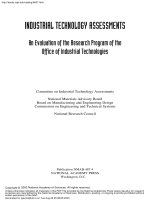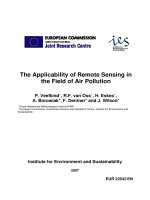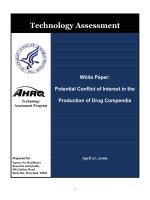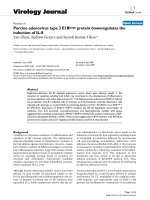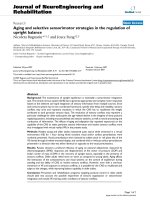Chapter 19: The Disposal of Portable Batteries doc
Bạn đang xem bản rút gọn của tài liệu. Xem và tải ngay bản đầy đủ của tài liệu tại đây (681.78 KB, 22 trang )
19
The Disposal of Portable Batteries
J. L. FRICKE and N. KNUDSEN
19.1 PORTABLE BATTERY SYSTEMS AND THEIR RELEVANCE TO
THE ENVIRONMENT
Batteries are generally galvanic cells which convert chemical energy into electrical
energy. As mobile sources of energy, we can no longer imagine life in the modern
world without them. Every year in Germany, approximately 1 billion portable
batteries are sold, an equivalent of around 30,000 tons (Table 19.1). We can state
that 85% of the battery market comprises non-rechargeable primary batteries and
15% rechargeable secondary batteries.
Since production and use of portable batteries have become of little ecological
relevance, the main focus has now turned to the spent product, the waste.
Avoidance, recycling, and then disposal is the order prescribed by the German Waste
Management and Recycling Act (law to promote life cycle management and to
ensure environmental ly friendly waste disposal (KrW-/AbfG) dated 27 September
1994). In principle, the battery industry is in agreement with these go als. It is even
setting an example to others in many fields. In so doing, the main focus is on
avoiding hazardous substances in terms of disposal and establishing recycling
procedures.
19.1.1 Main Systems and Their Implementation
In the following overview, you will find a selection of current electrochemical systems
and their typical areas of application (Table 19.2). These varied areas of application
Copyright © 2003 by Expert Verlag. All Rights Reserved.
Table 19.2 Areas of application.
System Area of application (example)
Primary batteries
AlMn Tape recorders, flashlights
ZnC Kitchen clocks, travel alarm clocks
Lithium Cameras
Round cell batteries R9 Toys, watches, hearing aids
Secondary batteries
NiCd Drill/drivers, electric toothbrushes
NiMH/Li-ion Mobile phones, laptop computers
Lead Starter and drive batteries
Round cell batteries R9 Calculators, computers
Source: GRS Batterien.
Table 19.1 Batteries brought into circulation by GRS users in 1999 and 2000.
1999 2000
in tons (app.) in tons (app.)
Primary
Round cells ZnC 9,206 9,118
AlMn 12,156 15,083
Zinc-Air 30 32
Lithium 264 351
Round cells R9 HgO 6.6 7.0
AgO 54 51
AlMn 31 34
Zinc-Air 45 44
Lithium 92 90
Subtotal 21,885 24,810
Secondary
Round cells Lithium-Ion 333 426
NiMH 672 1,689
AlMn 6.6 19
Pb 290 482
NiCd 1,840 1,840
Round cells R9 Lithium-Ion 0.5 4.7
NiMH 4.5 9.9
NiCd 1.5 3.9
Subtotal 3,138 4,475
Total 25,023 29,284
Source: GRS Batterien.
Copyright © 2003 by Expert Verlag. All Rights Reserved.
necessitated the manufacture of num erous sizes (Table 19.3). The R9 round cells also
come in a variety of sizes.
Depending on the electrochemical system, some portable batteries contain
hazardous substances such as mercury, cadmium, and lead. Table 19.4 shows an
overview of the main substances contained in portable batteries in percentages by
weight. (The material composition varies significantly depending on the battery size,
type, and composition. All figures are mean averages.)
Mobile applications of the future require both power and energy capacity and
low weight, a combination which can no longer be provided by conventional battery
types and systems. It is conceivable that in the future polymer electrolyte fuel cells
(PEMs) may even be used in the field of portable applications. Prototypes of laptops
and mobile phones which run on PEMs instead of conventional batteries have
already been developed.
19.1.2 Significance of Heavy Metals for Disposal
Without going into detail regarding the toxicity and ecotoxi city of the heavy metals
contained in batteries, it is clear that large quantities of mercury, cadmium, or lead
must not be disposed of in domestic waste disposal facilities (normal tips) as
contamination of the surrounding areas cannot definitively be prevented.
The basic principles of the European and, in particular, the German battery
industry therefore call for the avoidance of environmentally harmful substances in
battery systems or, where this is unavoidable, the separation and recycling of these
batteries. Avoidance is not always possible.
Lead and cadmium are used as active substances in lead batteries with up to
65% lead by weight and nickel/cadmium batteries with up to 15% cadmium by
weight. Mercury is used as a passive component in R9 round cells with up to 2% by
weight.
19.1.2.1 Mercury
In December 1998 (Directive 98/101/EU of 22.12.1998), as part of an amendment to
the existing 1991 battery directive (91/157/EEC), the European Commission banned
the marketing of batteries and accumulators with a mercury content of more than
5 ppm (parts per million) effective from January 1, 2000. The ban includes batteries
Table 19.3 The best-selling battery sizes.
International
designation
Conventional
designation AlMn ZnC Voltage (Volts)
AA Mignon LR 6 R 6 1.5
AAA Micro LR 03 R 03 1.5
C Baby LR 14 R 14 1.5
D Mono LR 20 R 20 1.5
9V E-block 6 LR 61 6 F 22 6 6 1.5 ¼ 9
4.5V Normal/flat 3 LR 12 3 R 12 3 6 1.5 ¼ 4.5
Source: Duracell GmbH.
Copyright © 2003 by Expert Verlag. All Rights Reserved.
Table 19.4 Main substances contained in batteries.
Non-
metals
Electrolytes Plastics,
Metals paper,
NH
4
Cl, Organ. carbon,
System Pb Ni Cd Zn Mn Ag Hg Li Fe H
2
SO
4
KOH ZnCl
2
Electr. H
2
O soot
Pb/PbO
2
65 81710
NiCd
(steel c.)
20 15 45 5 10 5
Zn/MnO
2
acid 20 25 20 5 10 20
alkaline 20 30 20 5 10 15
Zn/AgO
2
10 30 1 40 3 6 10
Zn/HgO 10 30 40 3 6 11
Zn/O
2
30 2 45 4 8 12
Li/MnO
2
30 2 50 10 10
Source: Batteries Association in the ZVEI.
Copyright © 2003 by Expert Verlag. All Rights Reserved.
and accumulators built into devices. Only round cell batteries and batteries
constructed from round cell batteries with a mercury content of not more than 2
percent by weight are excluded from this ban. This directive still awaits
implementation as national law.
The addition of mercury has been completely and successfully eliminated from
non-rechargeable portable batteries (primary batteries). The major battery suppliers
in Europe (they cover approx imately 95% of the market) have been offering them
mercury-free since 1994. The financial expenditure for the development and the
operating costs for mercury-free production were and still are considerable.
The waste strea m, however, will also continue to contain a certain amount of
mercury for some time after the mercury ban. This has consequences for the
recycling process (see Figure 19.1).
As another major contribution to the reduction of hazardous substan ces, the
European battery manufacturers had already decided in mid-1999 to cease sales of
mercury oxide round cell batteries, which are mainly used in hearing aids. As an
alternative, zinc/air batteries with a low mercury content (far less than 1 percent of
weight in Hg) are used. Advances made in hearing aids and battery technology now
make it possible to use these batteries even in hearing aids for the extre mely hard of
hearing. Zinc/air batteries have been on offer for ordinary hearing aids for more
than a decade now.
As part of the aforementioned implementation of the EU Directive, the
marketing of mercury oxide batteries should also be banned effective from January
1, 2000. This directive still awaits implementation in national law.
Batteries containing mercury are labelled as in Figure 19.2.
19.1.2.2 Cadmium
Batteries containing nickel/cadmium are rechargeable (secondary) batteries. They
are alkaline accumulators in which the positive mass consists primarily of nickel
Figure 19.1 Mercury content-recycling interdependence. Source: GRS.
Copyright © 2003 by Expert Verlag. All Rights Reserved.
hydroxide and the negative mass mainly of cadmium. The German Battery Decree
includes nickel/cadmium accumulators in the category of batteries containing
harmful substances. In certain areas of application, they are increasingly being
replaced with cadmium-free nickel/metal hydride ba tteries. Recently, lithium-ion
batteries have been offered on the market, particularly for laptop computers and
mobile phones. These, too, contain no mercury, cadmium, nor lead.
Batteries containing cadmium are labelled as in Figure 19.3.
19.1.2.3 Lead
A lead battery is an accumulator in which the electrodes consist primarily of lead,
while a diluted sulfuric acid is used as an electrolyte. The lead is used in the form of
bivalent and quadrivalent compounds (PbSO
4
and PbO
2
) and as a porous lead
sponge for active masses, as well as in the form of lead-antimony or lead-calcium
alloys for grids in lead batteries. The level of use of lead batteries in the portable
appliance market is low. The main areas of application are starter and drive batteries
as well as for uninterrupted power supply to stationary systems.
Batteries containing lead are labelled as in Figure 19.4.
A variety of battery systems will still be required in the future, as there will be
no such thing as a ‘‘universal battery’’ that is equally suitable for all applications.
Figure 19.3 Labelling of batteries containing cadmium. Source: BattV.
Figure 19.2 Labelling of batteries containing mercury. Source: BattV.
Copyright © 2003 by Expert Verlag. All Rights Reserved.
19.1.3 Basic Prerequisites for Recycling
19.1.3.1 Collection
Batteries must first be collected before they can be recycled. Portable batteries are
normally collected as a mixture, as end users cannot perform the meticulous
presorting required for recycling. Thus a comprehens ive nationwide system for the
collection of batteries has been developed and is in place today.
End users can either return their used portable batteries to their retailers or to
the collection points set up by the communities. Commercial end users are likewise
provided with collection and transport containers free of charge for the collection of
their used batteries. (GRS collection containers [see Figure 19.5].)
19.1.3.2 Sorting
Battery sorting facilities work according to different procedures. Two of them are
presented in brief in the following.
Sorting by Means of Electrodynamic Sensors
The EPBA/Sortbat and Eurobatri facilities work with electrodynamic sensors. This
process has already been implemented in routine operation for sorting portable
battery mixtures (see Figures 19.6 and 19.7).
The batteries are mechanically and magnetically sorted into different fractions
according to their composition, i.e. after hand sorting, during which incorrectly
sorted batteries and larger batteries are removed, they are sorted by size, and the R9
cells are sieved out. The round cells are run across a magnetic separator. The non-
Figure 19.5 Pictures of the GRS collection containers. Source: GRS Batterien.
Figure 19.4 Labelling of batteries containing lead. Source: BattV.
Copyright © 2003 by Expert Verlag. All Rights Reserved.
magnetic batteries (paper jacket, primarily ZnC, make up approximately 15% of the
round cells) are not sorted any further automatically. The magnetic batteries are
identified by an electrodynamic sensor based on their ‘‘magnetic fingerprints’’.
To put it simply, the sensor consists mainly of a spool through which current
flows, generating a magnetic field. Depending on which elect rochemical system is
passing the sensor at any given moment, the magnetic field changes. Based on this
change, the respective battery system is identified. This process sorts the batteries at a
speed of six batteries per second.
LSI has developed a new electrodynamic sensor which also facilitates the
separation of NiCd and NiMH batteries.
Sorting by Means of X-Ray Sensors
In this process , after hand and size sorting, the batteries are separated from a stock
silo via diff erent conveyor belts and fed to the x-ray sensor. The radioscopy unit
consists of an x-ray tube and a sensor installed in a radiation protection cabin. The
electrochemical battery type is identified in real time. The batteries fall off the
conveyor belt and are pushed out of their trajectory by compressed air blasts from
Figure 19.6 Battery sorting facility. Source: EPBA.
Figure 19.7 Processing principle of the battery sorting facility. Source: GMA, Schortens.
Copyright © 2003 by Expert Verlag. All Rights Reserved.
the side or from above. In this fashion several fractions can be reliably separated.
Sorting speeds of up to 10 batteries per second are achieved with battery intervals of
approximately 7 mm. The analysis ensues by computer, which likewise identifies the
battery types based on the gray levels of the x-ray image. A prototype of this system
has been in operation since early 2000.
The UV Detector
For the further recycling of the AIMn and ZnC systems it is important to separat e
the batteries containing mercury from the mercury-free batteries after separation
into the various electrochemical systems.
Since the mid-1990s, these batteries have been produced only in mercury-free
form by the European manufacturers, but older batteries or imported batteries
containing mercury still make their way into the waste disposa l system. In order to
separate these in the sorting facilities from the mercury-free batteries, for which
recycling procedures already exist, the European battery manufacturers have coded
their own AIMn brands and some of the ZnC batteries with a UV-sensitive varnish,
so that in future batteries containing mercury can be separated by means of sensors
from mercury-free batteries.
19.2 RECYCLING PROCEDURES AND LEVEL OF RECYCLING
Batteries contain a range of recyclable metals and can thus be used as sources of raw
materials. Below you will find a selection of the major recycling procedures for
portable batteries from the various electrochemical systems. There are sufficient
facilities to deal with round and button cell batteries containing lead, nickel/
cadmium, nickel /metal hydride, and mercury. For the newer nickel/metal hydride
and lithium systems, however, recycling is still in the early stages. For all the other
aforementioned systems, such procedures have been in place for some time now.
19.2.1 Lead Batteries
Lead can rightly be termed the classic recycling material. The first facilities for the
recovery of lead from used lead batteries were developed about 100 years ago. In the
beginning this was due exclusively to economic considerations, as lead has always
been a valuable raw material. With the dramatic growth of automobile traffic,
ecological aspects became increasingly important over the past few decades. What
has remained the same? The trick of using lead without consuming it.
There are basically two processes for recovering lead from used accumulators.
Either the battery waste is prepared before metallurgical processing and separated
according to composition (lead, plastic, acid, etc.), or the batteries are processed
whole. In the shaft furnace process, the second method is used. The batteries are
emptied of liquid acid and remain otherwise whole. Without further preparation
they are put into the shaft furnace, where they undergo metallurgical processing in a
mixture with aggregates such as coke, limestone, and iron. These aggregates enhance
the combustion and conversion processes in the shaft furnace and help to recove r the
lead stepwise and to purify it of contaminants. The result is raw or pig lead (see
Figure 19.8).
Copyright © 2003 by Expert Verlag. All Rights Reserved.
19.2.2 Nickel/Cadmium Batterie s
For the recycling of used Ni/Cd batteries, again only thermal procedures have
hitherto gained any significance. Generally, the cadmium is precipitated in a vacuum
or an inert atmosphere and the remaining steel-nickel compound is worked into iron-
nickel for steel production. Due to the comparatively small quantities of nickel/
cadmium batteries used (8000 tons/year), the capacities offered by the existing
facilities in Germany, France, and Sweden are sufficient for the recycling of all
batteries in Western Europe (see Figure 19.9).
19.2.3 Batteries Containing Mercury (R9 Cells)
In Germany, there are currently several processing facilities for batteries containing
mercury. Some of them work acco rding to the ALD procedure. This procedure is
used chiefly for the removal of mercury from mercury-containing components in
natural gas production and chlorine-alkali electrolysis. It can also be used for the
removal of volatile components from various materials and compounds. With the
ALD procedure, the mercury-containing waste products undergo vacuo-thermal
treatment. This is done in special, hermetically sealed facilities in batches. With
temperatures between 3508C and 6508C, the mercury vaporizes and then condenses
at lower temperatures (see Figure 19.10).
19.2.4 Nickel/Metal Hydride Batteries
Just after the market launch of nickel/metal hydride batteries, the German company
NIREC began work on the recycling of these batteries in order to put the nickel back
into the cycle of materials. The system places procedural emphasis on the separation,
reclamation, and use of the high-quality nickel content and the potential risk of
hydrogen. Due to the possibility of hydrogen being released as the NiMH batteries
are broken down, the processing must be done in a vacuum environment. Thus,
using a vacuum system, the batteries are passed through a cutting chamber which
opens up the casing and releases the stored hydrogen. This is constantly drawn off by
Figure 19.8 Functional diagram of the VARTA facility. Source: VARTA.
Copyright © 2003 by Expert Verlag. All Rights Reserved.
Figure 19.10 Recycling of R9 batteries containing mercury. Source: EPBA.
Figure 19.9 Recycling process of Accurec. Source: Accurec.
Copyright © 2003 by Expert Verlag. All Rights Reserved.
the difference in pressure. The batteries then go into a collecting tank. After expiry of
a stabilization period monitored by sensors and then aeration to render it inert, the
material can then be taken out. After separation of the plastic content, a usable
product is obtained with a high nickel content, which can then be reused as a
significant alloy component in stainless steel production (see Figure 19.11).
19.2.5 Lithium Batteries
Recycling procedures have also been developed fairly recently for the newer lithium
primary and secondary systems. They are currently in the pilot phase but the early
stages look promising. Thus, for example, the Mu
¨
lheim-based company Accurec has
developed the RVD (recycling through vacuum distillation) procedure for lithium
manganese oxide (Li-MnO
2
) batteries (see Figure 19.12).
Figure 19.11 Process diagram for the NiMH battery recycling facility. Source: NIREC.
Copyright © 2003 by Expert Verlag. All Rights Reserved.
S.N.A.M. in St. Quentin Fallavier (France) also offers a reprocessing
procedure for lithium secondary systems, which is currently in the pilot stage.
Here, after deactivation the metals are separated and returned to the production
cycle (Figure 19.13).
19.2.6 Zinc-Carbon and Alkali-Manganese Batteries
Previously, zinc-carbon and alkali-manganese batteries still contained mercury.
There wer e no recycling facilities and removal of the small quantities of mercury
using the existing recycling technologies was extremely costly. This resulted in two
major developments for the recycling of these batteries:
1. Development of technologies for the avoidance of mercury in these
primary batteries.
2. Development and promotion of battery-specific recycl ing processes to
extract mercury and other metals.
Figure 19.12 Recycling balance for lithium batteries. Source: ACCUREC.
Copyright © 2003 by Expert Verlag. All Rights Reserved.
In the early 1980s, the battery industry agreed to reduce the mercury content from
the then 1% by weight to ultimately reach 0% by weight in AlMn and ZnC batteries.
For some years now, European manufacturers have been producing these batteries
without mercury. As soon as the battery waste flow is nearly free of mercury, and
batteries containing mercury can be separated from mercury-free batteries in sorting
facilities, recycling makes economic and ecological sense (see Figure 19.14).
Below is a description of several recycling procedures for alkali-manganese,
zinc-carbon and zinc/air batteries.
Figure 19.14 Average composition of a primary battery. Source: EPBA.
Figure 19.13 Lithium-ion processing. Source: S.N.A.M.
Copyright © 2003 by Expert Verlag. All Rights Reserved.
19.2.6.1 Rotary Furnace
The rolling process is a metallurgical process carried out in an inclined furnace which
rotates around its own axis, known as the rotary furnace or drum furnace. The zinc-
containing waste is loaded into the rotary furnace together with aggregates (sands)
and reducing agents (coke). These flow through the rotary furnace, which is tilted
2.58, in a reverse flow to the hot process gases. The loaded material is thereby
gradually heated to the operating temperature. Within the material bulk, the zinc,
lead, and iron compounds are reduced at temperatures of up to 1300 8 C. Zinc and
lead evaporate due to their low vapor pressure. Fresh air is supplied in a counterflow
to the fixed bed flowing through the rotary furnace. Under these oxidizing
conditions, zinc oxide and lead oxide are formed again. These oxides leave the
furnace with the process gases. The waste gas first flows through the dust chamber,
where a part of the entrained dust as well as the material backflow caused by a
material jam in the furnace build up. This material is fed directly back into the
furnace. The waste gas is then cooled. In these downstream coolers and filters, the
metal oxides are emitted as high-quality rolled oxide. The process gas, which has
been purified of the rolled oxide, is then sucked through an adsorption filter to
remove gaseous pollutants. The material in the furnace, now largely free of zinc and
lead, together with the coke ash, forms the so-called rolled slag, which undergoes a
partial reoxidation of the iron near the furnace discharge area due to the prevailing
oxidizing conditions there. At the furnace discharge, this slag falls through a slag
chute into a water jet and is conveyed to a water basin in granulated form. The rolled
slag is used in, among other things, road construction. The rolled oxide is forwarded
to primary zinc foundries (smelting furnaces or electrolyses) and thus returned to the
zinc metal cycle.
19.2.6.2 The Imperial Smelting Process
Alkali-manganese and zinc-carbon batteries (up to a maximum of 100 ppm Hg) are
melted together with other preliminary materials. The zinc is reclaimed during the
gaseous phase and thus permanently separated from most of the accompanying
elements (Figure 19.15).
19.2.6.3 Electric Arc Furnace/Steel
Electric arc furnaces use a variety of processes to manufacture eithe r steel or
ferromanganese. In both cases the zinc is reclaimed as zinc dust and then converted
to pure zinc in the rotary furnace. Any slag that develops is used in road
construction. Electric furnaces are heated with electricity, eithe r by means of an
electric arc formed between two carbon electrodes or in an induction furnace by
means of resistance heating. Because contamination by fuel and firing gases cannot
occur, the soft electric steel is distinguished by its high degree of purity (see
Figure 19.16).
Nedstahl in Amsterdam now processes ZnC batteries in this way for the
Common Battery Recycling and Collection System run by battery manufacturers in
The Netherlands (STIBAT).
Copyright © 2003 by Expert Verlag. All Rights Reserved.
Figure 19.16 Steel production in an electric arc furnace. Source: EPBA.
Figure 19.15 System diagram. Source: MHD M.I.M.
Copyright © 2003 by Expert Verlag. All Rights Reserved.
19.2.6.4 Electric Arc Furnace/Ferromanganese
Valdi in Feurs (France) also offers this procedure for alkali-manganese and zinc-
carbon batteries containing mercury (Figure 19.17).
19.2.6.5 Converter Steel Furnace/Ferromanganese
Instead of the electric arc furnace, ZnC and AIMn mercury-free batteries can also be
processed in conventional converter steel furnaces. Tests have already been carried
out at the Duisburg copper foundry. Work is still in progress for the commercial use
of this process.
In the blast furnace, under the influence of the coke, the iron oxide is reduced
to raw iron and the material is separated into recyclable products. Zinc is vaporized
in the blast furnace and reclaimed in the gas purification process in the form of zinc
concentrate, which is forwarded to zinc foundries. The raw iron is run off from the
blast furnace in elementary form and the slag recycled.
19.2.6.6 Oxy Reducer
Citron, in Le Havre, France, offers this process, which emphasizes the recycling of
alkali-manganese and zinc-carbon batteries containing mercury (Figure 19.18). The
quality of the sorting is allegedly not so important in this process.
During the oxy reducer process,
. The waste is heated.
. Metals (e.g. Zn, Cd, Pb, etc.) are vaporized and oxidized.
. The mercury is condensed in metallic form.
. Organic components are completely burned off.
. The metal oxides are reduced.
Table 19.5 provides an overview of the procedures described above.
Figure 19.17 Ferromanganese production in electric arc furnaces. Source: EPBA.
Copyright © 2003 by Expert Verlag. All Rights Reserved.
Table 19.5 Overview of recycling processes.
Process Rotary furnace
Imperial smelting
furnace/ISF
Electric arc furnace/
EAF/steel
Electric arc furnace/
EAF/ferromanganese
Converter steel
furnace/
ferromanganese Oxy reducer
System
(examples)
BUS, Freiberg MHD, M.I.M.,
Duisburg,
Nedstahl, Ablasserdam
(Netherlands)
Valdi, Feurs (France) DK, Duisburg Citron, Le Havre
(France)
Battery input 10–20% 2–3% 2–3% 100% 2–3% 100%
Product Zinc oxide, slag
(alk.)
Zing, slag Zinc dust, slag, steel Zinc dust, slag,
manganese steel
Zinc dust, lead, slag,
raw iron
Zinc oxide, nickel-
cobalt alloy, iron
manganese oxide,
mercury
Source: GRS Batterien.
Copyright © 2003 by Expert Verlag. All Rights Reserved.
19.3 THE GERMAN BATTERY DECREE
The German Battery Decree (decree concerning the collection and disposal of used
batteries and accumulators (BattV) of March 27, 1998) came into force in two
phases: the first phase concerned labeling provisions and a ban on marketing and has
been in place since April 1, 1998. This is a direct implementation of the EU Directive.
The second phase concerned the obligations of the manufacturers, importers,
distributors, municipalities, and end consumers and had to be implemented by these
parties after October 1, 1998: Manufacturers and importers are obliged to provide
distributors and municipalities with suitable collecting tanks and must take away the
collected portable batteries free of charge.
Manufacturers/importers can join a common collection system or carry out
the collection individ ually. Individual collection by single manufacturers and via
third parties commissioned to do so is permitted in accordance with }4(3) in
combination with }16 of the German Bat tery Decree. This makes sense primarily for
batteries used for special purposes, in which batteries of one brand or type (e.g.
construction site batteries, lithium batteries for heat meters, etc.) occur in isolated
instances.
The distributors and municipalities have a duty to collect the batteries free of
charge and regardless of the brand or system.
Wherever batteries are sold, these must be taken back free of charge. However,
the public waste disposal services (districts and independent municipal entities)
will take back batteries free of charge from private end users and small businesses
Figure 19.18 Citron Process for the Recycling of Batteries. Source: Citron.
Copyright © 2003 by Expert Verlag. All Rights Reserved.
within the framework of the mobile and stationary collection of hazardous
substances.
It is not just a question of the manufacturers’ duty to collect, however; it is also
the end consumers’ duty to return the batteries. Regardless of their electrochemical
system and hazardous substance content, used batteries may no longer be disposed
of in domestic waste. The end us er is the first in the collection chain: he must return
used batteries to the distributors or the municipalities.
19.4 THE MANUFACTURERS’ COMMON COLLECTION SYSTEM
The new German Battery Decree obliged manufacturers and impor ters to take
charge of the sorting, recycling, and disposal of used portable batteries. Under }4(2),
the German Battery Decree provides for a common collection system among
manufacturers. As a result of this, Duracell, Panasonic, Philips, Energizer, Saft,
Sanyo, Sony, Varta, and the German Electrical and Electronic Manufacturers’
Association established a foundation: the Common Battery Collection and
Recycling System (GRS Batterien) as a non-profit organization. The Senate of the
City of Hamburg approved the foundation in May 1998.
The service provided by GRS is equally available to all manufacturers and
importers. The users of GRS pay a contribution towards waste disposal costs for the
batteries marketed by them in Germany, according to weight and system. The
foundation provides distributors and municipalities as well as commercial users wi th
appropriate collection and transportation containers free of charge and organizes
sorting and disposal in accordance with the German Battery Decree.
In the meantime, more than 400 manufacturers and importers of portable
batteries have joined GRS. These users put approximately 30,000 tons of portable
batteries into circulation in 2000.
There are now approximately 130,000 retail outlets equipped with an initial
240,000 collection boxes and 400,000 transportation containers in a closely meshed
network covering Germany nationwide. Numerous commercial users and nearly all
public waste disposal services likewise use the GRS collection system and have been
equipped with roughly 65,000 plastic containers for collection and pick-up.
Since 1998 the quantity collected has risen continuously. In 2000 9266 Mg were
collected, an increase of approximately 11% over 1999 (8336 Mg). In 2000, an
average of 112 g per head of the population was collected (see Figure 19.19).
Due to the increased circulation of UV-coded batteries, their sorting via UV
detectors, and the general reduction of the mercury content in the battery waste
stream thanks to the prohibition against bringing ZnC and AIMn batteries
containing mercury into circulation, the proportion of recycled batteries will rise
successively to over 70% in the year 2005 (see Figure 19.20).
End users have been made aware of the free battery disposal through numerous
public relations measures. Battery return has never before been so easy for end
consumers.
After the batteries have been collected, GRS Batterien organizes the sorting of
the batteries into the various electrochemical fractions and the subsequent disposal.
Between 6000 and 7000 orders per month reflect the resounding acceptance of the
system (see Figure 19.21).
Copyright © 2003 by Expert Verlag. All Rights Reserved.
Figure 19.19 Collection by land. Source: GRS Batterien.
Figure 19.20 Increase of share of recycling.
Figure 19.21 Batt-Man. Source: GRS.
Copyright © 2003 by Expert Verlag. All Rights Reserved.
For further information, please contact:
Stiftung Gemeinsames Ru
¨
cknahmesystem Batterien
Heidenkampsweg 44
D-20097 Hamburg
Tel: 0049 40 23 77 88
Fax: 0049 40 23 77 87
Mail: info@grs-batterien. de
Internet: www.grs-batterien.de
Copyright © 2003 by Expert Verlag. All Rights Reserved.

